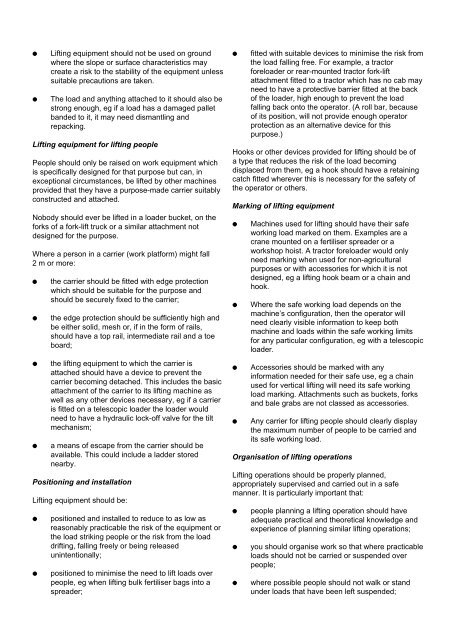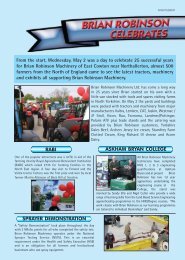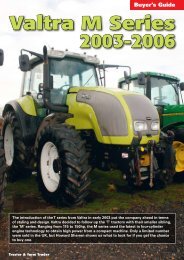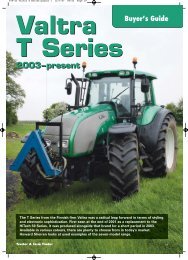HSE LOLER regulations factsheet - Brian Robinson Machinery
HSE LOLER regulations factsheet - Brian Robinson Machinery
HSE LOLER regulations factsheet - Brian Robinson Machinery
- No tags were found...
You also want an ePaper? Increase the reach of your titles
YUMPU automatically turns print PDFs into web optimized ePapers that Google loves.
●●Lifting equipment should not be used on groundwhere the slope or surface characteristics maycreate a risk to the stability of the equipment unlesssuitable precautions are taken.The load and anything attached to it should also bestrong enough, eg if a load has a damaged palletbanded to it, it may need dismantling andrepacking.Lifting equipment for lifting peoplePeople should only be raised on work equipment whichis specifically designed for that purpose but can, inexceptional circumstances, be lifted by other machinesprovided that they have a purpose-made carrier suitablyconstructed and attached.Nobody should ever be lifted in a loader bucket, on theforks of a fork-lift truck or a similar attachment notdesigned for the purpose.Where a person in a carrier (work platform) might fall2 m or more:●●●●the carrier should be fitted with edge protectionwhich should be suitable for the purpose andshould be securely fixed to the carrier;the edge protection should be sufficiently high andbe either solid, mesh or, if in the form of rails,should have a top rail, intermediate rail and a toeboard;the lifting equipment to which the carrier isattached should have a device to prevent thecarrier becoming detached. This includes the basicattachment of the carrier to its lifting machine aswell as any other devices necessary, eg if a carrieris fitted on a telescopic loader the loader wouldneed to have a hydraulic lock-off valve for the tiltmechanism;a means of escape from the carrier should beavailable. This could include a ladder storednearby.Positioning and installationLifting equipment should be:●●positioned and installed to reduce to as low asreasonably practicable the risk of the equipment orthe load striking people or the risk from the loaddrifting, falling freely or being releasedunintentionally;positioned to minimise the need to lift loads overpeople, eg when lifting bulk fertiliser bags into aspreader;●fitted with suitable devices to minimise the risk fromthe load falling free. For example, a tractorforeloader or rear-mounted tractor fork-liftattachment fitted to a tractor which has no cab mayneed to have a protective barrier fitted at the backof the loader, high enough to prevent the loadfalling back onto the operator. (A roll bar, becauseof its position, will not provide enough operatorprotection as an alternative device for thispurpose.)Hooks or other devices provided for lifting should be ofa type that reduces the risk of the load becomingdisplaced from them, eg a hook should have a retainingcatch fitted wherever this is necessary for the safety ofthe operator or others.Marking of lifting equipment●●●●Machines used for lifting should have their safeworking load marked on them. Examples are acrane mounted on a fertiliser spreader or aworkshop hoist. A tractor foreloader would onlyneed marking when used for non-agriculturalpurposes or with accessories for which it is notdesigned, eg a lifting hook beam or a chain andhook.Where the safe working load depends on themachine’s configuration, then the operator willneed clearly visible information to keep bothmachine and loads within the safe working limitsfor any particular configuration, eg with a telescopicloader.Accessories should be marked with anyinformation needed for their safe use, eg a chainused for vertical lifting will need its safe workingload marking. Attachments such as buckets, forksand bale grabs are not classed as accessories.Any carrier for lifting people should clearly displaythe maximum number of people to be carried andits safe working load.Organisation of lifting operationsLifting operations should be properly planned,appropriately supervised and carried out in a safemanner. It is particularly important that:●●●people planning a lifting operation should haveadequate practical and theoretical knowledge andexperience of planning similar lifting operations;you should organise work so that where practicableloads should not be carried or suspended overpeople;where possible people should not walk or standunder loads that have been left suspended;







